MBP® builds strong bones
MBP®The all-natural power of milk
MBP® is a natural protein that is present in trace amounts in bovine and human milk.
We at MEGMILK SNOW BRAND Co., Ltd. havediscovered the active mechanism of this milk protein, which we have named MBP®
MBP® is a registerd trademark of MEGMILK SNOW BRAND Co., Ltd. in Japan and U.S.A.
In humans, the bones are completely regenerated over a period of about three years.
Osteoclast cells destroy old bones, and osteoblast cells create new ones. This way, bones are regenerated little by little every day. MBP®is a useful part in this remodeling process.
MBP®’s most important characteristics are that it increases the number of bone-forming osteoblast cells and regulates the activity of bone-destroying osteoclast cells. This important multi-functional protein acts directly and indirectly on bone cells, vitalizes the bone itself and makes it more receptive to calcium, while at the same time preventing excessive calcium from being dissolved out of the bones.
Here is some information about how your bones can be fortified and made healthier, such as the secret of MBP®, the all-natural power of milk, and how bone rebuilding works.
About MBP®
What is MBP®?
MBP® is a natural protein present in trace amounts in bovine and human milk.
MBP® is a natural protein present in trace amounts in bovine and human milk.
It contains several bioactive ingredients.
MEGMILK SNOW BRAND took a special interest in this milk protein, and after many years of research, we were able to identify its active functions, naming it “MBP®.”
Although milk is rich in protein, MBP® accounts for only a small portion of milk’s overall protein content.

It is a key protein that works on bone cells to increase bone density and create healthier bones.
MBP®’s most important characteristics are that it increases the number of bone-forming osteoblast cells and regulates the activity of bone-destroying osteoclast cells.
However conscientious one may be in ingesting the proper amount of calcium, if the body’s ability to form bone is impaired, that calcium will not be efficiently absorbed into the bones.
MBP® is a multifunction protein that acts directly and indirectly on bone cells to reinforce the bone itself, making it more receptive to calcium while at the same time preventing excessive calcium from being dissolved from the bones.
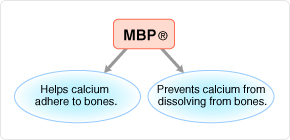
About whey
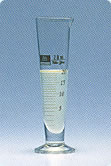 One common example of whey is the liquid that seeps out from yogurt.
One common example of whey is the liquid that seeps out from yogurt.
Although whey has long been known as a rich source of nutrients, it is only recently that its constituent ingredients have been closely examined and identified. Recent research has shown that whey contains MBP® and other ingredients that perform a variety of useful functions within the human body.
The structure and role of bones
Bone structure basics
Bones play a vital role in supporting our bodies. Here, we’ll take a look at the structure and role of bones.
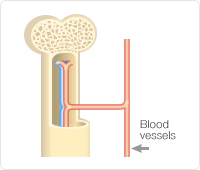
Living bones
For many people, bones bring to mind displays of museum dinosaurs or science classroom skeletal models. It's hard to imagine that bones are actually alive.
The reality, however, is that bones are interlaced with a network of narrow blood vessels that provide bone cells with essential energy and support.
Fractured bones are able to return to normal and grow healthy again because bone cells are constantly creating new bone material.
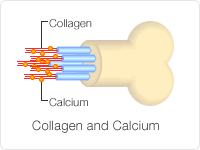
Bones - more than just blocks of calcium
Bones are constructed from more than just calcium. Another vital material in bones is collagen, a type of protein. If we were to think of bones as reinforced concrete, calcium would be the cement and collagen the reinforcing rods.
As shown in the diagram, new bone is created with a core of collagen, which helps bind the calcium together.
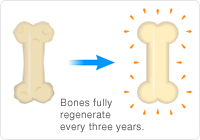
Gradual regeneration, day by day
Because bones are constructed from living tissue, old bones are constantly being broken down and replaced by new bones. In short, bones are reborn little by little, day after day.
In adults, bones are fully regenerated every three years. This cycle of regeneration starts from the moment we are born, and is repeated over and over, irregardless of age.
The functions of bones

Bones fulfill two major functions
The bones of all land animals, including human beings, fulfill two major roles. First, they support our bodies, giving us strong skeletal frameworks that enable us to live on land without collapsing under our own weight.
Second, they act as a storehouse for calcium, an element that plays a vital role in the functioning of cells throughout our bodies, as well as in the transmission of electrical impulses along our nerves. Although solid calcium is stored in our bones, it is also found in dissolved form flowing through our blood.
Moreover, the calcium in our bloodstream must be maintained at a constant level. When levels become low, calcium is dissolved from our bones and carried to cell tissues throughout various parts of the body. When plentiful, extra calcium is stored in our bones for future use.
The mechanism of bone regeneration
Two types of cells are active in the work of bone generation: osteoblasts and osteoclasts.
These cells keep busy by creating new bone material little by little, day after day.
Why do bones regenerate?
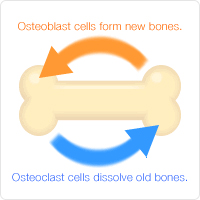 Bones continue to regenerate long after we reach our full height. Even when we become adults, bones continue to regenerate every three years. There are two reasons for this phenomenon.
Bones continue to regenerate long after we reach our full height. Even when we become adults, bones continue to regenerate every three years. There are two reasons for this phenomenon.
First, bones supply tissues throughout our bodies with calcium, serving a vital role in keeping us alive and healthy.
Bones function as storehouses for calcium, providing our bodies with calcium whenever there is a shortage and storing calcium when there is a surplus.
In short, bones are constantly regenerated through the constant release and storage of calcium.
Second, bones regenerate to replace old bones. Even strong bones lose their resilience and become fragile as they grow old. Regeneration ensures that bones remain strong and flexible.
The function of osteoblast cells
Osteoblasts are cells that build bones.
They produce collagen, the reinforcing rods of bones, then coat the collagen with a protein “glue” that holds the calcium in place.
Calcium from the bloodstream then automatically adheres to the collagen, forming new bone material.
The function of osteoclast cells
Osteoclasts are cells that dissolve bones.
They start out as a type of blood cell, but are transformed into osteoclasts within our bones through the action of hormones.
Osteoclast cells use acids or enzymes to dissolve the calcium and collagen from old bones. This dissolved calcium then reenters the bloodstream and is carried to different parts of the body.
But sometimes osteoclasts dissolve more calcium than is actually required-such as when the body’s hormonal balance is disrupted. This sort of imbalance is especially pronounced in women during menopause.
The main causes of osteoporosis are said to be calcium deficiency and the damage caused by overactive osteoclast cells. Suppressing the excessive activity of osteoclasts is therefore of vital importance.
Bone regeneration
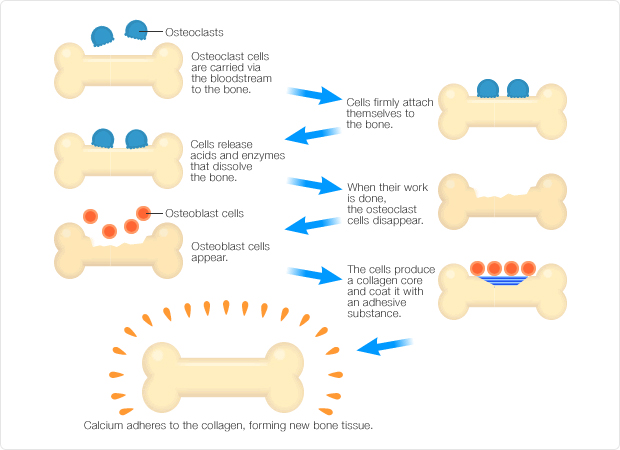
Bone structure by age

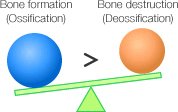
Growth period
Time to jump-start bone development!
Increased metabolism during the growth period means that bones are rapidly being formed and dissolved. But because bone formation is more pronounced at this stage, the body continues to grow larger. During this period, food and exercise are vital to growth. Bone mass is said to increase until approximately age 20 in the backbone, and until age 30 in the arms and legs.

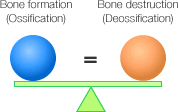
Maturity period
Preparing for the future with strong bones
By the time we reach our 30s, our bodies are fully grown and our bone mass peaks. It is a period when bone formation and bone destruction are in balance. At this time of life, a balanced diet is important to delay the onset of a future decrease in bone mass.

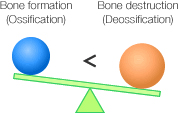
Aging
Protecting your bones from osteoporosis
From the 40s onwards, bone mass enters a gradual decline. While both bone formation and destruction become weaker during this period, bone destruction overtakes bone formation. And when this situation progresses to a dangerous level, osteoporosis sets in. It is therefore extremely important to delay the onset of bone mass reduction as much as possible.
The power of MBP®
MBP® is a substance that works directly and indirectly on both osteoblast and osteoclast cells.
By stimulating the activity of osteoblasts while suppressing excessive activity in osteoclasts, MBP® effectively supports the formation of healthy bones.
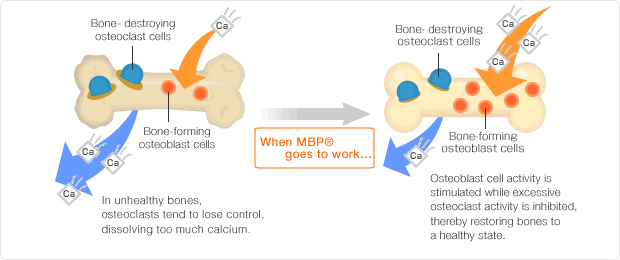
The calcium we ingest is wasted unless it reaches our bones.
Because calcium cannot be synthesized in the body, we need to ensure that we consume sufficient calcium in our diet each and every day. Calcium that enters the body is absorbed from the intestines into the bloodstream and then carried to the bones.
But if the calcium we ingest is not incorporated into our bones, it simply flows out of the body as waste.
A new approach to healthier bones - stimulating bone activity to maximize calcium utilization
 The new approach we recommend for building healthier bones is to ensure that the precious calcium we ingest is stored in the bones, not wasted. MBP® proves especially effective in this new approach.
The new approach we recommend for building healthier bones is to ensure that the precious calcium we ingest is stored in the bones, not wasted. MBP® proves especially effective in this new approach.
It’s important to ensure that we consume sufficient calcium every day and get enough exercise, but it’s not enough. Our new approach to building healthier bones is based on a comprehensive understanding of the mechanism of bone regeneration and effective use of MBP®, a substance that works directly and indirectly on bone cells.
The effects of MBP®
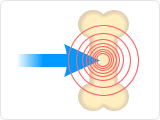 ・Increases bone-forming osteoblast cells
・Increases bone-forming osteoblast cells
・Stimulates osteoblastic collagen production
・Suppresses bone destruction by osteoclast cells
・Maintains healthy bone metabolism, tissue and structure
